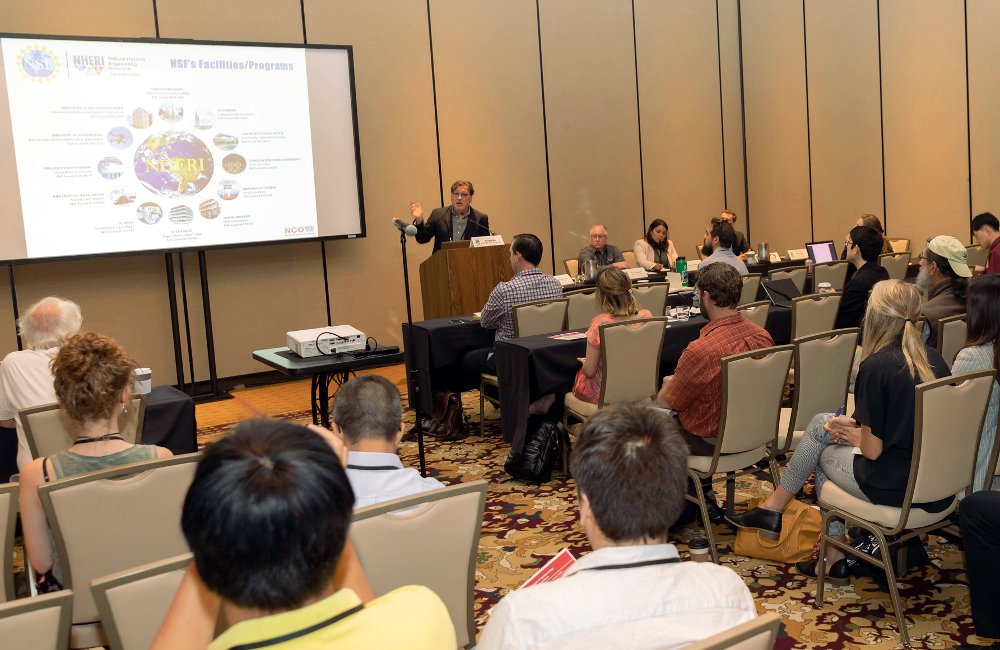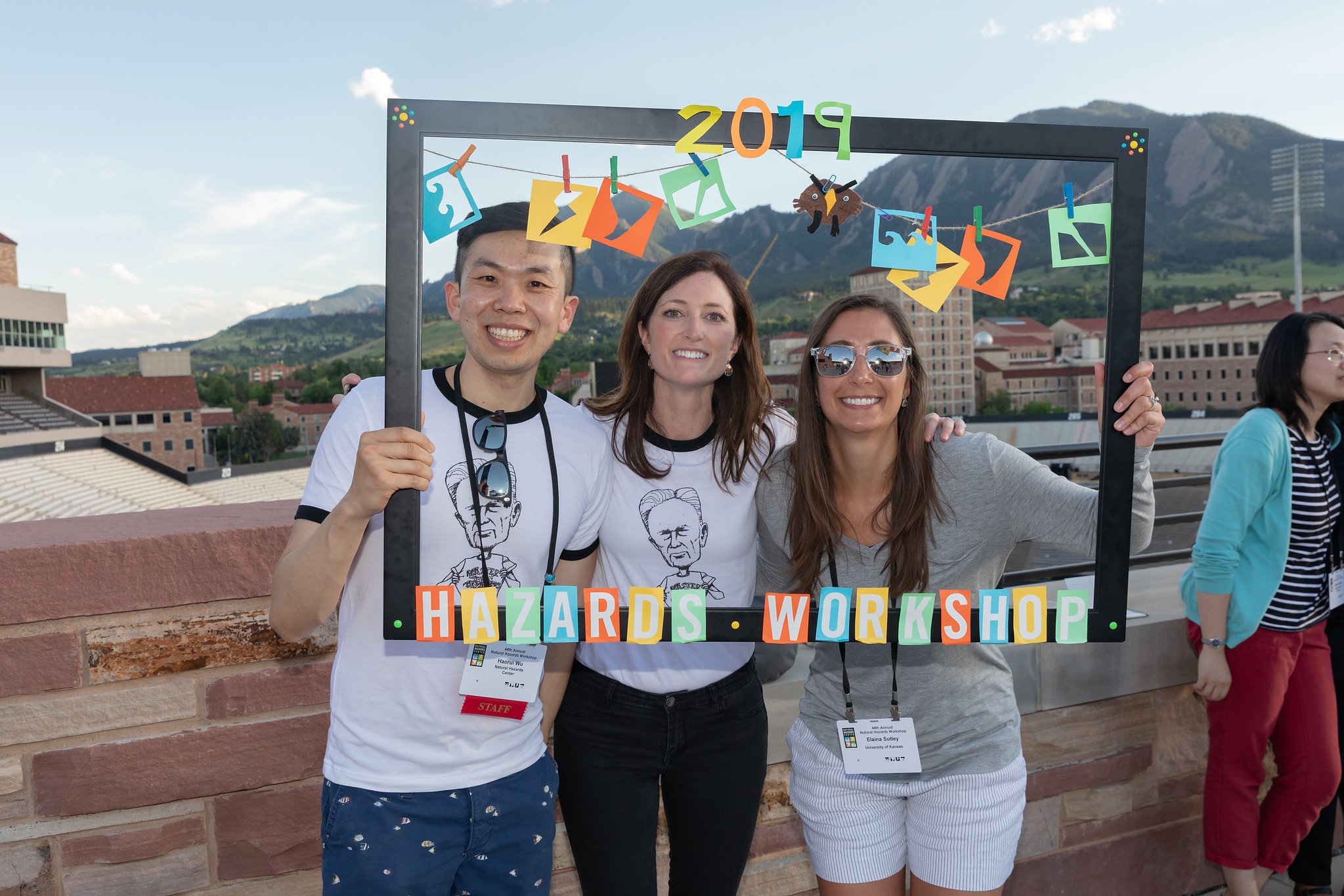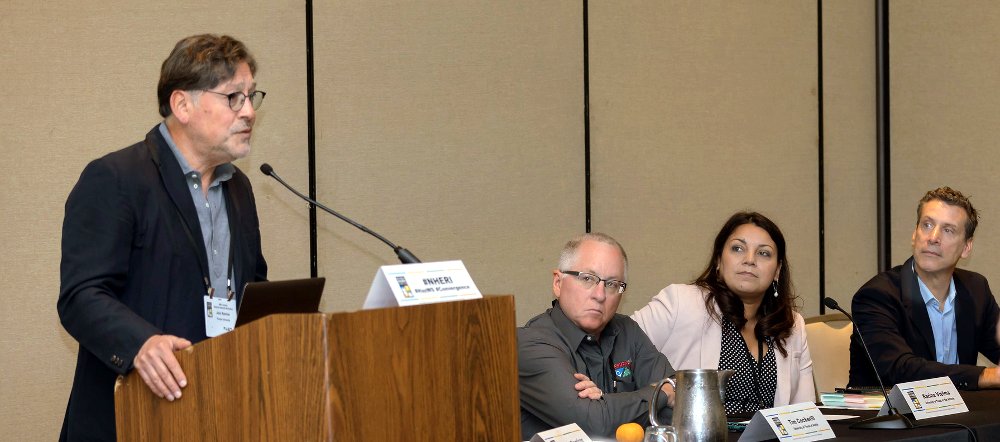NHERI at the 2019 Natural Hazards Workshop and Researchers Meeting
Published on August 2, 2019

Julio Ramirez, PI of the NHERI NCO, introduces the NHERI network at the Natural Hazards Research and Applications Workshop.

Enjoying the Workshop. From left: Haorui Wu, postdoctoral researcher for NHERI CONVERGE, Lori Peek, PI for NHERI CONVERGE and director of the Natural Hazards Center, and Elaina Sutley, NHERI researcher and assistant professor at the University of Kansas.
For 44 years, the Natural Hazards Center at the University of Colorado Boulder has hosted the Natural Hazards Research and Applications Workshop. This year, the meeting focused on the theme of Convergence and brought together 661 individuals who are dedicated, in a variety of ways, to alleviating the harm and suffering caused by disasters.
At this years event, held July 14 to 17 in Broomfield, Colorado, representatives from the various components of the National Science Foundation-supported Natural Hazards Engineering Research Infrastructure, NHERI, presented in a special session on the importance of the shared-used engineering facilities, cyberinfrastructure, and multi-disciplinary research coordinating networks for the nation.
The Natural Hazards Workshop convenes a diverse range of academic researchers and students, local/state/federal officials, and non-profit and private sector professionals. More than 50 people from these various sectors attended the session dedicated to the NHERI facilities. Because the Workshop has long attracted large numbers of social scientists, public health researchers and practitioners, urban planners and others, this was a major opportunity to share the power and potential of the NSF-funded research infrastructure with a broader community.
An introduction. Julio Ramirez, principal investigator of the NHERI Network Coordination Office (NCO), introduced the NHERI network and the numerous shared-use resources available for mitigating the impact of earthquakes, windstorms, tsunamis, and other associated hazards on the nations civil infrastructure. Ramirez discussed the importance and role of the NHERI Science Plan in guiding the research of NHERI users.
In addition, he shared a new video highlighting the NHERI network. Dan Zehner, NHERI facility scheduler and operations coordinator, worked with the NSF media team and representatives from the NHERI facilities to create the two-minute overview. It was a hit with the Workshop audience and will be widely distributed soon. Following the remarks by Ramirez, Karina Vielma, co-administrator of the Education and Community Outreach committee for NHERI, discussed the networks outreach efforts and introduced the NHERI undergraduate researchers who were in attendance.
The cyberinfrastructure. Tim Cockerill, co-PI of the NHERI DesignSafe Cyberinfrastructure (CI), discussed the advantages of the networks natural-hazard-focused CI and encouraged social scientists many of whom recently provided feedback on a draft data model to further explore and use its data publishing and sharing tools.
Reconnaissance and simulation tools. Joe Wartman, PI for the NHERI RAPID facility, explained the goals and capabilities of the RAPID center. He introduced participants to the RAPIDApp for mobile data collection which has been developed by RAPID and now is being augmented with additional social science functionalities through a partnership with the CONVERGE facility. Following Wartmans presentation, the SimCenters Matt Schoettler provided a brief description of SimCenter activities, which generated interest from many of those who do scenario modeling in the audience.

The NHERI panel at the 44th annual Natural Hazards Workshop included the NCOs Julio Ramirez, Design-Safes Tim Cockerill, the ECOs Karina Vielma, and the RAPIDs Joe Wartman.
Lori Peek, director of the Natural Hazards Center and PI for the NHERI CONVERGE facility, was thrilled with the cross-disciplinary research connections formed at this years meeting. She says that while the Workshop has long served as a center of gravity for the hazards and disaster research community, the infusion of the leaders and students from the NHERI network has brought a crucial new dimension.
The research generated from NHERI, the resources that are available, and the effective coordinating structure are all vital for reducing disaster losses and promoting resilience, Peek observed. I think the social scientists and practitioners at the Workshop were truly excited to learn from this panel and to think about new opportunities for collaboration.
The Workshop was a great success, added Ramirez. Congratulations are due to the entire Natural Hazards Center team of professionals and the student volunteers for orchestrating such an informative and inspiring event.
He says that NHERI will certainly be on-hand for next years Workshop (July 12 to 15, 2020) and Researchers Meeting (July 15 to 16, 2020).







